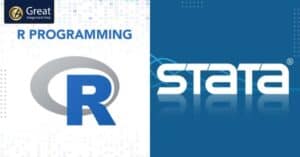Would you like to know the major differences between R and Stata? Do you wish to update your knowledge of R vs. Stata? Well, you are in the right spot.
If you are a programming or a statistics student, then probably you would have heard of the programming languages R and Stata. But if you are a beginner to programming, then you would be unfamiliar with these languages. Often, some students confuse R with State. So, to help them all, in this blog post, we have shared the comparison between R and Stata and which one is better for data science.
Continue reading this blog post to know more about R vs. Stata. But before getting in-depth into the comparison, let us see a short overview of both programming languages.
What is R?
R is one of the most popular statistical programming languages in the world and is widely used by the majority of statistical communities. It was developed in the year 1985 and was officially released in 1995. The language got its name ‘R’ from the initials of the names of two developers – Ross Ihaka and Robert Gentleman. The main objective behind the development of R was to help academic statisticians to perform complex data analysis. Mainly, R is used for statistical computation and graphics. Also, it offers high-level graphics, interfaces to other languages, and debugging facilities. Companies such as Facebook, Google, Twitter, Microsoft, Uber, Airbnb, etc use R.
What is Stata?
Stata is one of the most popular statistical software that is used in more than 180 countries across the globe. The software was created by Stata Corp in the year 1985. It is used to analyze, manage, and produce a graphical visualization of data. Stata primarily analyzes the data patterns. As Stata is user-friendly and offers a command line as well as a graphical user interface, several professionals and researchers around the world consider it powerful and trustworthy software. Predominantly, researchers in the fields of economics, biomedicine, and political science use Stata to examine different data patterns.

R vs. Stata: Strengths
Find here the strengths of R and Stata.
Strengths of R
- Contains a wide range of functions
- Implements a new statistical method quickly
- It is simple to automate and integrate with Git, MicroStrategy, ODBC, Oracle R Enterprise, Apache Hadoop, etc.
- Free third-party community support is available
- A comprehensive help section is available for free
- Supports object-oriented programming language
- Compatible with Windows, Linux, macOS, and all other common platforms
- Safe and sustainable because of the very large and active developer community
Read More:- SAS vs SATA: Get to Know the Key Differences
Strengths of Stata
- Provides almost every established statistical method
- Easy to automate
- Affordably priced when compared to commercial competition
- Easily accessible through the GUI
- Older versions are compatible
- Stable community support
- Compatible with Windows, macOS, and Unix
- Extensive literature available
- Three-year release cycle provides investment security
R vs. Stata: Weaknesses
Listed below are some weaknesses of R and Stata.
Weaknesses of R
- R syntax is challenging to learn.
- The stability and quality of little-used packages aren’t as good as the core distribution.
- Powerful hardware is required while working with large data sets.
Weaknesses of Stata
- Version updates are slow.
- Tough to integrate with other software.
- Open only one data set at a time.
R vs. Stata: Other Key Differences
There are several differences between R and Stata. Here, let us have a look at some key differences.
Ease of Learning
In general, it is more difficult for a person from a non-programming background to learn and understand a new programming language. Therefore, for statistics students, it will be hard to learn R from scratch. But the language can be learned with the help of free sources provided by R.
R is an open-source programming language that has a special community for developers. Through that community, any member can showcase their expertise. Also, some members of the community voluntarily extend their help to those who face any issues with the R code.
On the other hand, it is easy to learn Stata software. Like R programming, Stata also offers community support to the users. The members of the Stata community also help to fix problems that are related to Stata. Even some experts in the community teach Stata to the newbie. To their users, Stata also offers extensive learning support in the form of blogs, tutorials, webinars, training, journals, etc.
Online Support
R is a free open-source programming language. Therefore, it is difficult to find official support online. But if needed, you can get help with R using its documentation, community support, manuals, journals, etc.
Stata is paid software. Hence, you can find formal online support. Starting from online support to FAQs, documentation, video tutorials, web resources, Stata news, and webinars, Stata offers extensive support to its users.
Cost
As R is free, you can download it from the internet and install it without paying a single penny.
But on the other hand, the cost of Stata software starts at $179.00 per year per user. In general, Stata is available in different versions for students, education, government, and business. Also, it provides the new purchase, upgrade, and renewal facility of the packages. The Stata software licenses are available in different categories such as single-user, multi-user, and site licenses. Free trials for a limited period are available for Stata.
Updates
R offers a lot of different updates at regular intervals. You can get the updates or the latest version of R on its official website. Also, R provides updates on its packages that allow you to stay updated with the data science environment.
On the other hand, Stata is slow in updating its version. Mostly, Stata updates its version at a one-year interval. Moreover, you can get the latest update only with the licensed version of Stata.
Speed
To write a file of 458 MB of raw text, Stata takes 67.25 seconds whereas R consumes 72.93 seconds. However, when compared to R, Stata exports files 8 % faster.
Read More:- Minitab vs. Excel: Learn the Major Differences
R vs. Stata: Applications
Here, let us have a look at the application of R and Stata.
Applications of R
- R is widely used in descriptive statistics. In particular, it is used to summarize the important features of the data. Besides that, R serves several other purposes such as measurement of variability, skewness, and central tendency.
- It is a powerful tool for exploratory data analysis. R contains the best data visualization library called ggplot2.
- With R, both discrete and continuous probability distribution can be analyzed effectively.
- Hypothesis testing for validating statistical models can be done with R.
- With the help of the tidy verse package of R, it is easy to organize and preprocess data.
- The most interactive web application package in R is Eshiny with which interactive web applications that can easily be embedded on web pages can be developed.
- Predictive models that work with the integration of machine learning algorithms can be developed in R.
Applications of Stata
- Stata provides a simple and easy-to-use Graphical User Interface (GUI). It is user-friendly because it uses the click GUI and the point.
- The GUI of Stata gives plenty of menus and dialog boxes. By using those dialog boxes, plenty of essential features such as data management, data analysis, and statistical analysis can be accessed.
- As Stata has the command line feature, it is considered developer and programmer-friendly software. Its command line features, allow programmers to type the commands and run them. In the results window, the solutions to the command will be displayed.
- Stata offers a wide range of advanced components to work efficiently. While using the functions and performing operations, with the help of a data editor, live data can be seen.
- Stata provides data management capabilities in a way to take full control over data sets. Especially, with the help of Stata, the data sets can be linked together and reshaped quickly.
- In Stata, graphs can be created effectively using the pointing and clicking method and the command line method. All the created graphs can be printed, published, and exported. It supports a variety of file formats such as EPS, TIF, PNG, and SVG. If needed, the graph can be edited in Stata using an integrated graph editor.
How is R Better than Stata?
While Stata and R are both strong statistical software programs used for data analysis, R is a better option in many cases due to several unique characteristics. First of all, a large user and development community can freely modify and improve upon R since it is an open-source language. Moreover, this gives R exceptional versatility and the capacity to handle an extraordinarily wide range of analytical tasks by facilitating the easy integration of an almost infinite number of specialized packages and functions. On the other hand, Stata is a proprietary program that has fewer features out of the box and frequently costs money for extra modules or plug-ins.
When compared to Stata’s more complex syntax, R’s programming language is more approachable and English-like, making it simpler for novices to learn and for seasoned analysts to generate clear, legible code. Additionally, R easily interfaces with other widely used data science tools and programming languages, such as Python, enabling a more streamlined and effective workflow. Conversely, Stata may seem less interoperable and more isolated from the larger community of data analysis tools.
R has substantially more statistical modeling possibilities and advanced analytical approaches. R’s statistical capabilities greatly outperform those of Stata, including Bayesian approaches, time series analysis, and machine learning algorithms. This makes R the best option for handling complicated, cutting-edge research topics and deploying advanced predictive models. While Stata is a good choice for basic econometric analysis, it cannot compete with R’s sheer strength and variety.
How is Stata Better than R?
Both Stata and R are strong statistical software packages used by researchers and data analysts. Nevertheless, Stata has some specific benefits that make it the better choice in many scenarios. Stata is well-known for its ease of use and intuitive interface, which allows even inexperienced users to easily navigate the software and utilize its powerful analytical features. In comparison, R can have a higher learning curve, necessitating more sophisticated programming abilities to properly utilize its functionalities. This accessibility element is especially significant for researchers and professionals who need to study data quickly without spending too much time learning sophisticated software.
Stata includes a large collection of pre-built statistical commands and functions that span a wide variety of analytical techniques, from regression modeling to time series analysis. This broad package of tools allows users to do complicated analyses with relative ease, without the need to develop lengthy custom code, as is frequently required with R. Stata’s streamlined workflow and readily available statistical instructions can save users a lot of time and effort, allowing them to focus on analyzing results rather than struggling with program technicalities.
Furthermore, Stata’s documentation and support resources are often viewed as superior to those provided by R. While R allows for a great degree of flexibility and customization, Stata’s mix of power, user-friendliness, and complete support makes it a more appealing option for many academics and data analysts who value efficiency, productivity, and ease of use in statistical work. Stata’s user-friendly interface, rich analytical tools, and easily available support resources help to solidify its position as a superior option to R in a variety of applications.
Conclusion
We hope you have gained a better understanding of R vs. Stata. Basically, R is a programming language and hence you can perform a lot of things with it than Stata. If you have basic coding knowledge or if you are familiar with the coding environment, then for data science, we would recommend using R. In case, you have no coding knowledge, then you can very well go with Stata. When compared to R, Stata is easy to use.


